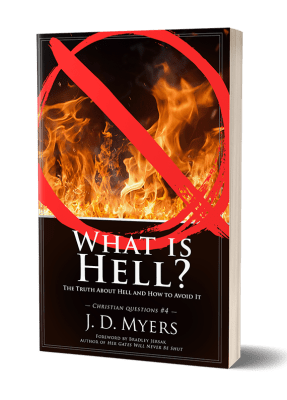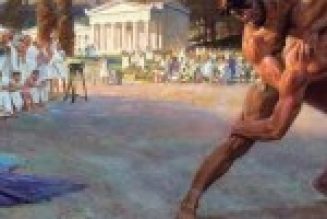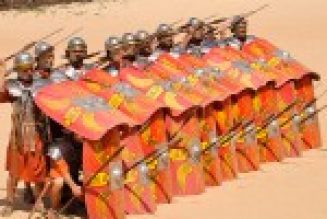 My book, What is Hell? is now available on Amazon. I am doing a series of podcast studies that focus on some of the content from the book. The studies look at the eight key terms that are often equated with hell, and about a dozen key passages that are thought to teach about hell.
My book, What is Hell? is now available on Amazon. I am doing a series of podcast studies that focus on some of the content from the book. The studies look at the eight key terms that are often equated with hell, and about a dozen key passages that are thought to teach about hell.
If you want to learn the truth about hell and what the Bible actually teaches about hell, make sure you get a copy of my book, What is Hell?
Also, if you are part of my discipleship group, there will be an online course about hell as well.
In this article, we are considering the story of the Rich Man and Lazarus in Luke 16:19-31. This is probably the premier passage in the Bible that convinces people about the reality of hell as a place of eternal suffering and torment. But is this really what Jesus is teaching in this text?
No. In fact, when people use Luke 16:19-31 to terrorize others about hell, they end up missing the entire point of the story.
Does Luke 16:19-31 teach about torment in hell?
Every discussion of fire (or hell) in Scripture must include an examination of the story of Lazarus and the rich man from Luke 16:19-31. With its detailed and lurid depiction of the suffering of a rich man in the flames of hell, this account appears to support all the horrifying ideas of hell as a place of eternal torture for the unredeemed.
 Luke 16:19-31 contains the portrayal of a man being tormented in flames, who cries out for just a drop of water to cool his burning tongue (cf. Luke 16:23-24). When most people think of hell, this is the sort of image they have in mind.
Luke 16:19-31 contains the portrayal of a man being tormented in flames, who cries out for just a drop of water to cool his burning tongue (cf. Luke 16:23-24). When most people think of hell, this is the sort of image they have in mind.
One of the main verses in this passage which seems to teach about the reality of torment and suffering in the flames of hell is Luke 16:24. Here is what it says:
Luke 16:24. “Then he cried and said, ‘Father Abraham, have mercy on me, and send Lazarus that he may dip the tip of his finger in water and cool my tongue; for I am tormented in this flame.’”
Yet not everyone is convinced that Jesus is describing a literal place with literal flames where literal people suffer and burn for all eternity.
Several factors reveal that Jesus intended some other sort of message with this story.
1. Do you really go to hell by neglecting the poor?
First, if this is a story about how to escape hell and go to heaven when you die, then the lesson of the story is that eternal life and entrance into heaven can be earned by being poor, or at least by being generous to the poor. If you don’t take care of the poor, then off to hell with you!
But is this what Scripture teaches anywhere else? No. Far from it.
Eternal life is the free gift of God to everyone and anyone who simply and only believes in Jesus for it (John 3:16; 5:24; 6:47). While there are many blessings and benefits connected to taking care of the poor, escaping hell is not one of them.
2. Are believers and unbelievers all in the same giant “cavern” of hell?
Second, the presence of Abraham and Lazarus in the same vicinity as the suffering rich man does not fit any other portrayal of hell.
In other words, if Jesus is describing the place where the unredeemed dead spend eternity, then what is Abraham doing there, and why does Lazarus get sent there? Is there some sort of annex or suburb of hell where the redeemed can live in relative peace and safety while looking across the chasm at the sufferings of the poor sinners in the torture chamber of hell?
Though many scholars try to explain this away by speaking of “Abraham’s Bosom” as a temporary holding tank for the redeemed which was then emptied at the resurrection of Jesus, such an idea is tenuous at best and is not taught anywhere else in Scripture.
To the contrary, the image of “Abraham’s Bosom” comes from Babylonian intertestamental Jewish literature. The Babylonians believed that there was a single afterlife location for all the dead, and this dwelling place had two regions, one for the righteous and one for the wicked.
Some of the Jewish people living in Babylon picked up on this idea and began telling stories about something similar for Jews. A few of these accounts (which are now found in the Babylonian Talmud) speak of “Abraham’s Bosom” as the place that righteous Jews went after they died.
But no passage from Scripture teaches this concept.
 The fact that Jesus refers to it in this story should not be read as an endorsement of the idea, but as a way of using a common image from that culture to make a theological point.
The fact that Jesus refers to it in this story should not be read as an endorsement of the idea, but as a way of using a common image from that culture to make a theological point.
I’ve mentioned it before, but if I began to tell you about meeting Peter at the Pearly Gates, you would know I was using this common folktale image to tell a fictional (and possibly humorous) story, but you would not imagine that I was speaking of a literal place or that people who die actually appear before Peter at the Pearly Gates.
So also with Jesus referring to a common folk-tale about Abraham’s Bosom. He was using the imagery, not because it is correct, but because it helped make the ultimate point Jesus wanted to make. We’ll see what that point was in bit.
3. This story appears to be a parable
Third, despite the claims of some, this story of Jesus contains all the markings of a parable.
There are numerous and significant elements of this story that are parallel to the other parables in the preceding context.
For example, both this story and the Parable of the Unjust Steward begin with the words “There was a certain rich man” (Luke 16:1, 19). These two parables focus the reader’s attention on certain rich men of Luke 16:14 and how their treatment of the poor was an abomination to God (Luke 16:15). Some of the other contextual parallels are considered below.
The only real reason some people think this is not a parable is that Jesus specifically names two characters: Abraham and Lazarus. No other recorded parable of Jesus provides a proper name for any of the key human characters.
However, “Satan” is mentioned in Mark 4:14, “the son of man” as a title for Jesus in Matthew 13:37, and several personal titles in Luke 10:25-37. Many believe that the story of Job is a parable, in which case, it contains the names of several people.
Furthermore, outside of Scripture, many ancient parables often used the names of people in the telling of the stories. So the presence of two names in Luke 16 fails to prove the story is not a parable.
Some speculate that maybe Jesus used the name of a popular beggar who was well-known in the streets of Jerusalem. The other possibility (as mentioned previously) is that Jesus was referencing a popular Jewish folktale which His hearers would have immediately recognized as fiction.
Again, just because someone mentions Peter’s name when speaking of the Pearly Gates, this does not mean they are referring to a literal location or future event.
4. Jesus Speaks of Hadēs Instead of Gehenna
Fourth, everywhere else Jesus speaks about individual people in “hell,” He uses the word gehenna, which referred to the Valley of Hinnom outside the walls of Jerusalem. But here Jesus uses the word hadēs (Luke 16:23).
Elsewhere, Jesus uses this word only as a way of describing the destruction that will come upon certain cities (Matt 11:23; 16:18; Luke 10:15; 16:23).
Furthermore, the word hadēs was a Greek word for the abode of the dead, and was also the name of the Greek god of the netherworld. Once again, this provides evidence that Jesus is not speaking about hell (the way He understands it), for then He would have used the word gehenna.
Instead, Jesus uses a word that He typically uses to refer to the destruction of cities, combines in the Greek idea of the afterlife, mixes in some Babylonian imagery of two compartments in hell, and uses this all in connection with the Jewish history and Jewish folktales.
Why? Because this approach makes a memorable story.
Jesus is clearly mixing images from numerous sources so that He can tell a parable to His listeners that will connect with them on multiple levels. Jesus is making a point that He doesn’t want His audience to miss.
Ironically, due to the Christian preoccupation with sinners burning in the flames of hell, we have mostly missed the point of Jesus. But what was that point? The context makes it quite clear.
5. Contextual Keys Help us Understand Luke 16:19-31
This context is the fifth and final piece of evidence that helps us know that the story of the Rich Man and Lazarus is a parable rather than a description of a literal place.
Jesus has been making one single point in the preceding context, and this story hammers that point home.
The setting for the context is found in Luke 15:1-2. After Jesus welcomes and spends time with the sinners and tax-collectors, the Jewish religious leaders chide Him for eating and befriending such people. They believe it is better to remain separate and distant from such wicked people.
So Jesus sets out to correct this entire line of thinking. In doing so, Jesus tells five parables.
The first three parables explain why Jesus does what He does, and what will come of His actions. These are the Parables of the Lost Sheep (Luke 15:3-7), the Lost Coin (Luke 15:4-10), and the Lost Son, also called the Parable of the Prodigal Son (Luke 15:11-32).
The third parable is transitionary. It not only shows how the younger son went into a far country to squander his inheritance, but also introduces the elder son, who stayed at home and worked the family farm. Yet as the story closes, it becomes obvious that the Prodigal Son, or the Lost Son, is not the one who went into a far country, but is rather the one who remained.
It is the elder son who is actually furthest away from the heart of his father, and wants to keep separate from his sinful, wayward, younger brother. The father invites the older son to the feasting and dancing, but the son refuses, preferring to stay instead in the darkness outside the party. Because he was angry, he would not go in (Luke 15:28).
It is also helpful to recognize that this third parable, the Parable of the Lost Son, not only serves as a transition to the stories that follow, but also serves as a parallel (but opposite) story to that of the Rich Man and Lazarus.
In other words, the story of the Rich Man and Lazarus is an inversion of the story of the Prodigal Son.
-Both the prodigal son and Lazarus find themselves in desperate situations. Both beg for scraps.
-Both are in the company of unclean animals (dogs, swine)
-Both stories have father figures: The rich man calls Abraham his “father.” Lazarus leans on Abraham like the prodigal son is held by his father.
-Both contain a theme of distance—there is a great distance between the rich man and Lazarus, and between the father as his wastrel son (in “a far country”). Unlike the father who sees his son from a long way off and runs to meet him, the rich man maintains his structural distance and indifference to the poor, so he sees Lazarus “far away” with Abraham.
-Both the prodigal son and the rich man live sumptuously, but then lose everything. But the prodigal son “comes to his senses” while the rich man does not change his way of thinking. He still treats Lazarus like an inferior wanting him to bring him water with “the tip of his finger,” and then to warn his brothers. He is still thinking of his own status and social group, not of the poor. (Bartlett, Seven Stories, 90-91.)
After these three parables about His own mission and ministry, with the third parable ending with a depiction of the religious rulers as the elder son, Jesus transitions to two other parables, both of which focus on the ministry of the religious rulers. Jesus is seeking to contrast His ministry with theirs by showing where their methods and goals come from and what their methods and goals accomplish.
The first parable that Jesus tells about the ministry of the religious leaders is the Parable of the Unjust Steward (Luke 16:1-13). Though many assume that Jesus is describing how His followers are supposed to function in this world, this is not the point of the parable. If it were, Jesus would be telling His followers to cheat their employers and live unscrupulous lives for the sake of gaining favor with others and wealth for themselves.
Does this sound like something Jesus would teach? No. Quite to the contrary, this sounds like the opposite of what Jesus would teach. And indeed, it is.
People get confused, though, because they think that Jesus applies the Parable of the Unjust Steward to His followers in Luke 16:9-12, where He seems to say that we should use riches and wealth for making friends with others.
But notice Jesus basically says, “And when your money fails, they will welcome you into their home for ever and ever” (Luke 16:9). We all know that this is not true. If Jesus was actually “applying” the parable here, then He is flat-out wrong.
Therefore, it is better to see that this so-called “application” in Luke 16:9 is not the application at all, but is a tongue-in-cheek sarcastic reference to how the people of this world will not treat you when your wealth is gone.
Jesus is saying, “If you use money to gain friends, don’t be surprised that when your money runs out, so will your friends. Though they may promise that you will always be welcome in their home, this promise only lasts as long as your money does.”
This is reality, and this is also exactly what Jesus just taught in Parable of the Lost Son. When the son’s money ran out, he had no home to go to, and was sent to live with the swine, and no one gave him anything (Luke 15:14-16).
So the Parable of the Unjust Steward is not about how the disciples of Jesus should act and behave, but is instead about how the world works, and how the religious leaders act and behave to gain friends and influence for themselves.
Many of the religious leaders had become very rich by making deals with merchants and political leaders. They were using mammon the way the world used it, to benefit and enrich themselves, and get more money and power for themselves.
Yet it is not just finances that they dealt with; they also trafficked in the forgiveness of sins.
Religious leaders have always sold the forgiveness of sins to others for money. Such a practice did not begin with the selling of indulgences by the Catholic Church in the days of Martin Luther.
The religious leaders were also engaging in this practice in the days of Jesus. Though the religious leaders were supposed to be stewards of the things of God, they were actually using their position to not only cheat others, but to also cheat their master, God.
Jesus, however, gave away forgiveness for free, which is the only way it can be given. But this free forgiveness to the sinners and tax-collectors did not make Him popular among the religious crowd, for it threatened both their teachings and their livelihood.
John the Baptist threatened the religious establishment as well, which is why they had him killed. This is why Jesus mentions John in Luke 16:14-18. John had challenged Herod about his marriage to Herodias (Matt 14:1-12), which eventually led to Herod beheading John.
This event in the life of John also explains why Jesus throws in the teaching about marriage and divorce in Luke 16:18. This is not a non-sequitur, but logically follows what Jesus has said about John. John’s condemnation of the divorce and remarriage of Herodias led to John’s death. This, Jesus says, is what true followers of God can expect from those who live according to the values and principles of this world.
Now the Pharisees knew that they were being derided by Jesus, and so they sought to deride Him (Luke 16:14). This proves once again, that the Parable of the Unjust Steward is not about how followers of Jesus are to behave in this world, but is instead about how some corrupt religious leaders behave.
The Pharisees knew Jesus was talking about them, and they were offended. But Jesus says that their behavior, though highly esteemed among men, is an abomination to God (Luke 16:15).
Their use of mammon and religion to garner favor with the rich and the powerful was a great sin before God. It was an abomination that would lead to their desolation.
Luke 16:19-31, the Parable of the Rich Man and Lazarus
And indeed, this is exactly what Jesus goes on to describe in Luke 16:19-31, the Parable of the Rich Man and Lazarus. The “Rich Man” obviously represents the rich men who are discussed in the context, which is the Pharisees who were “lovers of money” (Luke 16:14). They were servants of mammon (Luke 16:13). Like the unjust steward, they used their money and position to make friends with the rich and to enrich themselves.
What were they supposed to do with their money and power instead?
They were to use it to take care of the poor and needy in their midst. Like who? Like Lazarus, who was covered in sores and laid at the gate, desiring just a few crumbs from the rich man’s table (Luke 16:20-21).

At what gate did Lazarus lay?
In the days of Jesus, there were Gentile converts to Judaism who were called “gate proselytes.” Since they were Gentiles, they were kept in the outer “Court of the Gentiles” and could not even pass through the gate into the Court of Women. Many of them wanted to draw nearer to the temple and to God, but were barred from access.
So they would hang out at the gate, peering through its opening, and longing to be closer to God. But the religious leaders kept these Gentile proselytes at a distance. They were sinners who could not draw near to God.
If Lazarus was a Gentile proselyte, that is, a “gate proselyte,” then not only was he overlooked and neglected for his sores and starvation, but also for his desire to serve and honor God.
But now, in this story, the entire situation is reversed.
Lazarus is with Abraham, the father of the Jewish faith, while the rich man is far off, thirsty, and separated. And the rich man begs Abraham to send Lazarus to warn his five brothers. But Abraham tells the rich man that his brothers can listen to Moses and the prophets.
Apparently, Moses and the prophets contain enough instruction and warning to keep a person from experiencing the fate of the rich man.
And what is the central and overriding theme of Moses and the prophets? It was that the people of God are to take care of the poor and needy in their midst. Though there are many sins which Moses and the prophets teach against, the overriding theme of the prophetic message is that God’s people must defend the orphans and the widow, provide for the foreigner and the stranger, and take care of the poor and needy.
They must do this themselves; not by demanding the government make laws which force others to do such things. This generous and loving activity was the clear sign that God was in their midst.
So what then is the story of the Rich Man and Lazarus all about?
It is the concluding story of a series of five parables, and it summarizes them all by revealing the danger of living according to the way of this world.
This world worships mammon, and uses money to gain friends and power. But greedy living and lusting after money does not satisfy or quench one’s thirst for meaning or significance in this world. Money satisfies those who chase after it less than a drop of water on the tongue would satisfy a man who is burning in flames.
The quest for money does not quench one’s thirst. No matter how much you have, it leaves you desiring more.
The story of the Prodigal Son depicts a man who started out chasing after money, but discovered it was worthless (Luke 15:11-32).
The story of the Unjust Steward shows how this world uses and responds to money (Luke 16:1-13). The Pharisees didn’t like what Jesus was saying (because they were guilty of such actions), and so in an attempt to justify their own greed, complained about His teaching and derided His message (Luke 16:14).
So Jesus provides the example of John, who was a Just and Faithful Steward. John was not greedy and did not use money to make friends with the rich and powerful, but was instead beheaded by them (Luke 16:15-18).
And now all of these lessons about greed are wrapped up into the one story of the Rich Man and Lazarus.

Ultimately, the story of the Rich Man and Lazarus is a warning against greed.
In Luke 16:15, Jesus identifies the love of money as an abomination to God. The Parable of the Rich Man and Lazarus illustrates that greed does not accomplish the righteousness of God, or help one experience the kingdom of God.
Instead, it only invites flames into one’s life. Greed brings nothing but desolation and destruction. Greed, and the money which comes with it, does not help one experience the kingdom of God in this life or the next.
The flames in this story, then, are “no more literal than Abraham’s bosom. The flames represent the burning agony of his thirsty soul. The rich man is experiencing the agony of thirst and deprivation that Lazarus had known throughout life” (Jersak, Her Gates Will Never Be Shut, 102).
We see this by the two different words used to describe the experience of the rich man in this story.
He was in torment (Gk., basano)
First, Jesus says that the rich man was in “torment” (Gk., basano) in hadēs (Luke 16:23). The word literally refers to a touchstone, which was used in ancient times as a way to test the value and genuineness of the gold and silver found in coins and jewelry.
“While the rich man looks fancy on the outside, when placed under the ‘touchstone’ his veneer comes off. He is being revealed for who he really is … and the revelation is agony” ( Butler, The Skeletons in God’s Closet, 77).
He was tormented (Gk., odunōmai)
Second, the word used for “tormented” (Gk., odunōmai) in Luke 16:24-25 can also “be translated as ‘grief’ or ‘anguish’ and conveys a sense of emotional turmoil rather than physical pain” ( Butler, The Skeletons in God’s Closet, 76).
It is only used two other times in the New Testament, both by Luke.
In Luke 2:48, it refers to the “anxiousness” that Mary and Joseph felt as they searched for Jesus in Jerusalem for three days when He was twelve.
Then in Acts 20:38, it refers to the “sorrow” that the Ephesian elders experienced when they said goodbye to Paul, knowing that they would never see him again. In neither case does it refer to torture, but to intense emotional grief or anguish.
So the rich man is not being tortured.
Instead, he is having the truth revealed to him about himself, about Lazarus, and about what God values in the world. And for a man who has put all his hope in worldly riches and social status, the truth is more than he can bear.
The truth is a torment to him. Too late, he discovers that everything he worked for and sought after during his entire life is worthless in this life and the next. And since he cannot accept this truth, he remains in emotional torment and even seeks to continue the life he knew and loved.
We see this in the fact that, even in death, the rich man attempts to command and control Lazarus. He tells Lazarus to bring him a drop of water and to go warn his five brothers about the fate that awaits them. Even in his state of torment, he prefers to stay where he is and order Lazarus around than beg for forgiveness or ask for the opportunity to come over to where Lazarus reclines with Abraham.
Furthermore, in his continued haughty arrogance, the rich man never speaks to Lazarus but only to Abraham (Luke 16:24, 27, 30). Even though their roles are reversed, the rich man shows only disdain and derision for Lazarus (cf. Luke 16:14).
Notice that in response, however, “Abraham does not call [the rich man] ‘fool,’ ‘disappointment,’ or ‘idiot,’ but ‘son.’ This is an expression of fatherhood, of filial devotion, of care” ( Butler, The Skeletons in God’s Closet, 74). Abraham and Lazarus are on the side of love while the rich man continues in his self-centered mindset.
Ultimately, then, the great gulf that separates the rich man from Abraham and Lazarus is a divide of his own making (Luke 16:26).
It cannot be crossed, because the rich man will not cross it, for doing so would require him to admit that he is no better than Lazarus. This he cannot do, and so his riches, his racism, and his religious arrogance keep him separated from others.
Furthermore, though Lazarus and Abraham may want to cross the divide to the rich man, they cannot, for the division is not of their making.
The rich man is the one who creates the divide, so that those on Abraham’s side of the chasm who “might want to pass” (i.e., act out of compassion) in fact cannot. The text clearly implies that the rich and privileged, those with status, create the divide, not God. Thus the parable is not a picture of medieval hell but of humanly-created alienation and its suffering.
The chasm is a spiritual parallel in death to the social chasm fixed in life by the rich man’s caste. By making it impossible for the poor or the sinner to cross that great gulf into their pseudo-kingdoms and religious enclaves, the spiritually privileged were unwittingly defining their own distance from God’s kingdom.

In the end, Luke 16:19-31 is a condemnation of greed
Luke 16:19-31 is a picture of how life looks from God’s perspective when the rich create chasms between themselves and the poor and needy.
Though the rich could learn much and benefit greatly from the refreshing presence of the poor and needy among them, they separate themselves from those who are considered “beneath” them. And though the religious elites claim to follow the law and the prophets, their actions and behavior show that they know nothing of what Scripture teaches.
Those who rest and live in the way of Abraham, and now those who follow the teachings and example of Jesus, will live in solidarity with the sick, the poor, and the outcast, for it is among them that the kingdom of God most naturally lives and grows.
So what are the rich to do? They should use their wealth to serve, honor, protect, and provide for the poor in their midst. They must use their wealth to serve Jesus in the kingdom of God.
In this way, they avoid the torment of hell in their lives here and now, and experience the joy and fulfillment of the kingdom of heaven instead.
 Do have more questions about hell? Are you afraid of going to hell? Do want to know what the Bible teaches about hell? Take my course “What is Hell?” to learn the truth about hell and how to avoid hell.This course costs $297, but when you join the Discipleship group, you can to take the entire course for free.
Do have more questions about hell? Are you afraid of going to hell? Do want to know what the Bible teaches about hell? Take my course “What is Hell?” to learn the truth about hell and how to avoid hell.This course costs $297, but when you join the Discipleship group, you can to take the entire course for free.











